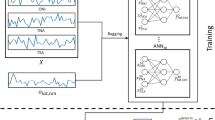Abstract
A possibility of the early prediction of El Niño and La Niña phenomena taking into account their two types (Central Pacific and East Pacific ones) is studied. The prognostic model is based on the method of artificial neural networks. A set of global climate indices for the period of 1950–2019 is used as the input parameters of the model. The indices are calculated using monthly mean NCEP/NCAR reanalysis data on 500 hPa geopotential height and sea-level pressure. The model is verified for the period of 2010–2019. A possibility of the successful forecast of Niño 3.4, Niño 4, and Niño 3 indices with a lead time of 3 to 9 months is shown. The quality of the forecast decreases as its lead time increases, but remains generally high. It is found that the model can predict well the El Niño beginning and evolution and, a bit worse, La Niña events; in this case, the number of La Niña events is overestimated as the forecast lead time increases.


Similar content being viewed by others
REFERENCES
A. S. Lubkov, E. A. Voskresenskaya, and O. V. Marchukova, “Forecasting the Southern Oscillation Index,” Vestnik Sankt-Peterburgskogo Universiteta. Nauki o Zemle, No. 4 (2017) [in Russian].
S. Osovskii, Neural Networks for Data Processing (Finansy i Statistika, Moscow, 2002) [in Russian].
K. Ashok, S. K. Behera, S. A. Rao, H. Weng, and T. Yamagata, “El Niño Modoki and Its Possible Teleconnection,” J. Geophys. Res., 112 (2007).
G. Barnston and R. E. Livezey, “Classification, Seasonality and Persistence of Low-frequency Atmospheric Circulation Patterns,” Mon. Wea. Rev., 115 (1987).
A. G. Barnston, H. M. van den Dool, S. E. Zebiak, T. P. Barnett, M. Ji, D. R. Rodenhuis, M. A. Cane, A. Leetmaa, N. E. Graham, C. F. Ropelewski, V. E. Kousky, E. A. O’Lenic, and R. E. Livezey, “Long-lead Seasonal Forecasts—Where Do We Stand?”, Bull. Amer. Meteorol. Soc., 75 (1994).
A. Gavrilov, A. Seleznev, D. Mukhin, E. Loskutov, A. Feigin, and J. Kurths, “Linear Dynamical Modes as New Variables for Data-driven ENSO Forecast,” Climate Dynamics, 52 (2019).
S. Haykin, Neural Networks, a Comprehensive Foundation (Macmillan College Publishing Company, New York, 1994).
Y. He and A. G. Barnston, “Long-lead Forecasts of Seasonal Precipitation in the Tropical Pacific Islands Using CCA,” J. Climate, 9 (1996).
N. K. Larkin and D. E. Harrison, “Global Seasonal Temperature and Precipitation Anomalies during El Niño Autumn and Winter,” Geophys. Res. Lett., 32 (2005).
A. S. Lubkov, E. N. Voskresenskaya, and A. S. Kukushkin, “Method for Reconstructing the Monthly Mean Water Transparencies for the Northwestern Part of the Black Sea as an Example,” Atmos. Ocean. Opt., 29 (2016).
M. J. McPhaden, S. E. Zebiak, and M. H. Glantz, “ENSO as an Integrating Concept in Earth Science,” Science, 314 (2006).
S. G. Philander, El Niño, La Niña and the Southern Oscillation (Academic Press, San Diego, CA, 1990).
E. M. Rasmusson and T. H. Carpenter, “Variations in Tropical Sea Surface Temperature and Surface Wind Fields Associated with Southern Oscillation (El Niño),” Mon. Wea. Rev., 110 (1982).
S. Saha, S. Moorthi, X. Wu, J. Wang, S. Nadiga, P. Tripp, D. Behringer, Y.-T. Hou, H. Chuang, M. Iredell, M. Ek, J. Meng, R. Yang, M. P. Mendez, H. van den Dool, Q. Zhang, W. Wang, M. Chen, and E. Becker, “The NCEP Climate Forecast System Version 2,” J. Climate, No. 6, 27 (2014).
K. Takahashi, A. Montecinos, K. Goubanova, and B. Dewitte, “ENSO Regimes: Reinterpreting the Canonical and Modoki El Niño,” Geophys. Res. Lett., 38 (2011).
H. M. van den Dool, “Searching for Analogues, How Long Must We Wait?”, Tellus A, 46 (1994).
E. N. Voskresenskaya, O. V. Marchukova, V. N. Maslova, and A. S. Lubkov, “Interannual Climate Anomalies in the Atlantic-European Region Associated with La Niña Types,” IOP Conf. Ser.: Earth Environ. Sci., 107 (2018).
Y. Xue and A. Leetmaa, “Forecasts of Tropical Pacific SST and Sea Level Using a Markov Model,” Geophys. Res. Lett., 27 (2000).
S.-W. Yeh, J.-S. Kug, B. Dewitte, M.-H. Kwon, B. P. Kirtman, and F.-F. Jin, “El Niño in a Changing Climate,” Nature, 461 (2009).
Y. Yuan and H. M. Yan, “Different Types of La Niña Events and Different Responses of the Tropical Atmosphere,” Chin. Sci. Bull., 58 (2013).
Y. Yuan, H. Yang, and C. Y. Li, “Study of El Niño Events of Different Types and Their Potential Impact on the Following Summer Precipitation in China (in Chinese),” Acta Meteorol., Sin., 70 (2012).
H. Zhang, P.-S. Chu, L. He, and D. Unger, “Improving the CPC’s ENSO Forecasts Using Bayesian Model Averaging,” Climate Dynamics, No. 5–6, 53 (2019).
W. Zhang, L. Wang, B. Xiang, L. Qi, and J. He, “Impacts of Two Types of La Niña on the NAO during Boreal Winter,” Climate Dynamics, 44 (2014).
I. V. Zheleznova and D. Yu. Gushchina, “Circulation Anomalies in the Atmospheric Centers of Action during the Eastern Pacific and Central Pacific El Niño,” Russ. Meteorol. Hydrol., No. 11–12, 41 (2016).
Funding
A.S. Lubkov is the winner of the contest of young scientists’ reports at the International Youth School and Conference on Computing and Information Technologies for Environmental Sciences “CITES-2019” on May 27–June 6, 2019, Moscow, Russia (http://www.scert.ru/ru/conference/cites2019/). The research was funded by Russian Foundation for Basic Research (projects No. 18-45-920063 and No. 20-45-920015) and by the state assignment of the Institute of Natural Technical Systems within the research theme No. 0012-2019-0007.
Author information
Authors and Affiliations
Corresponding author
Additional information
Russian Text ©The Author(s), 2020, published in Meteorologiya i Gidrologiya, 2020, No. 11, pp. 111-121.
About this article
Cite this article
Lubkov, A.S., Voskresenskaya, E.N. & Marchukova, O.V. Forecasting El Niño/La Niña and Their Types Using Neural Networks. Russ. Meteorol. Hydrol. 45, 806–813 (2020). https://doi.org/10.3103/S1068373920110084
Received:
Revised:
Accepted:
Published:
Issue Date:
DOI: https://doi.org/10.3103/S1068373920110084




